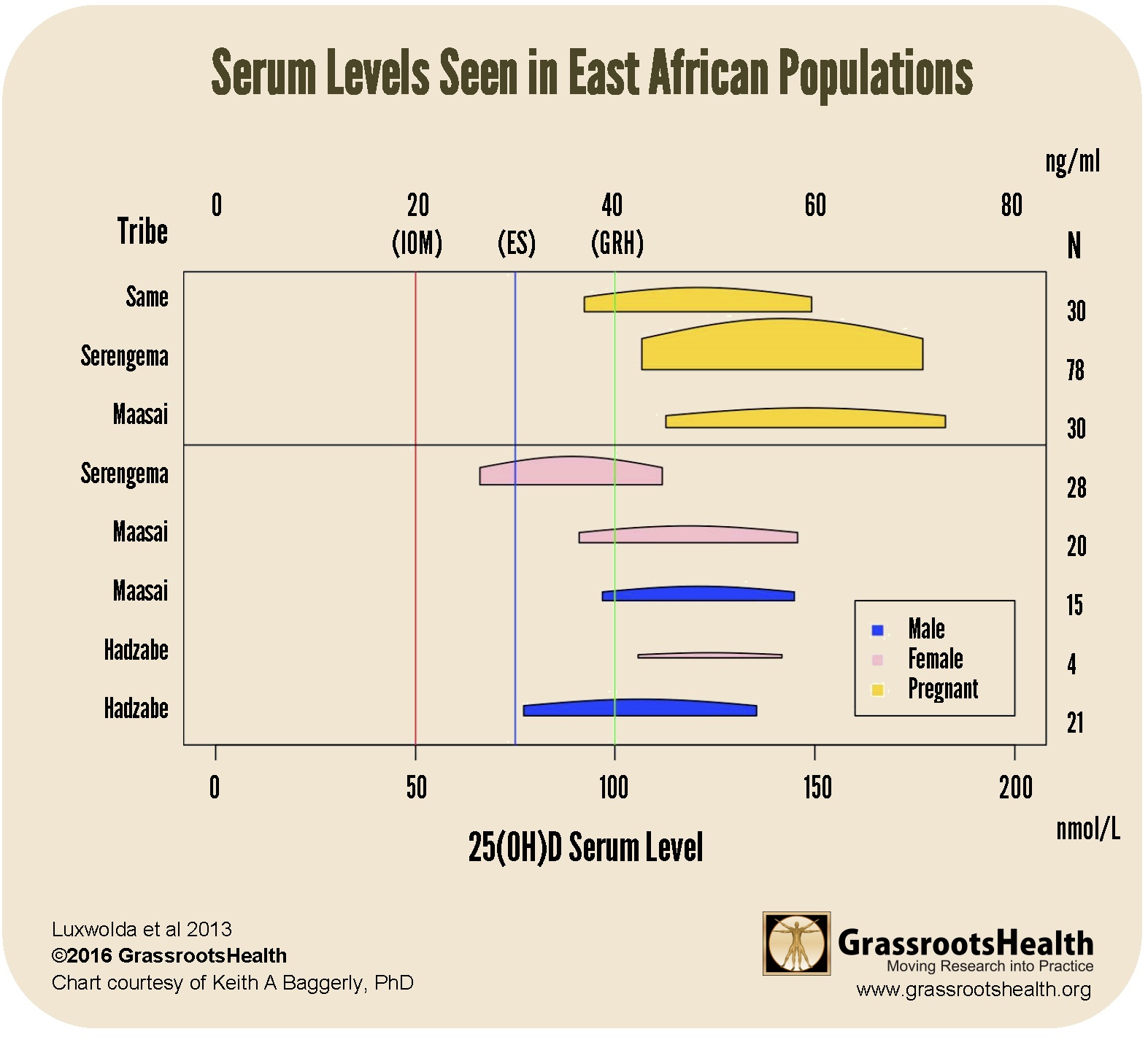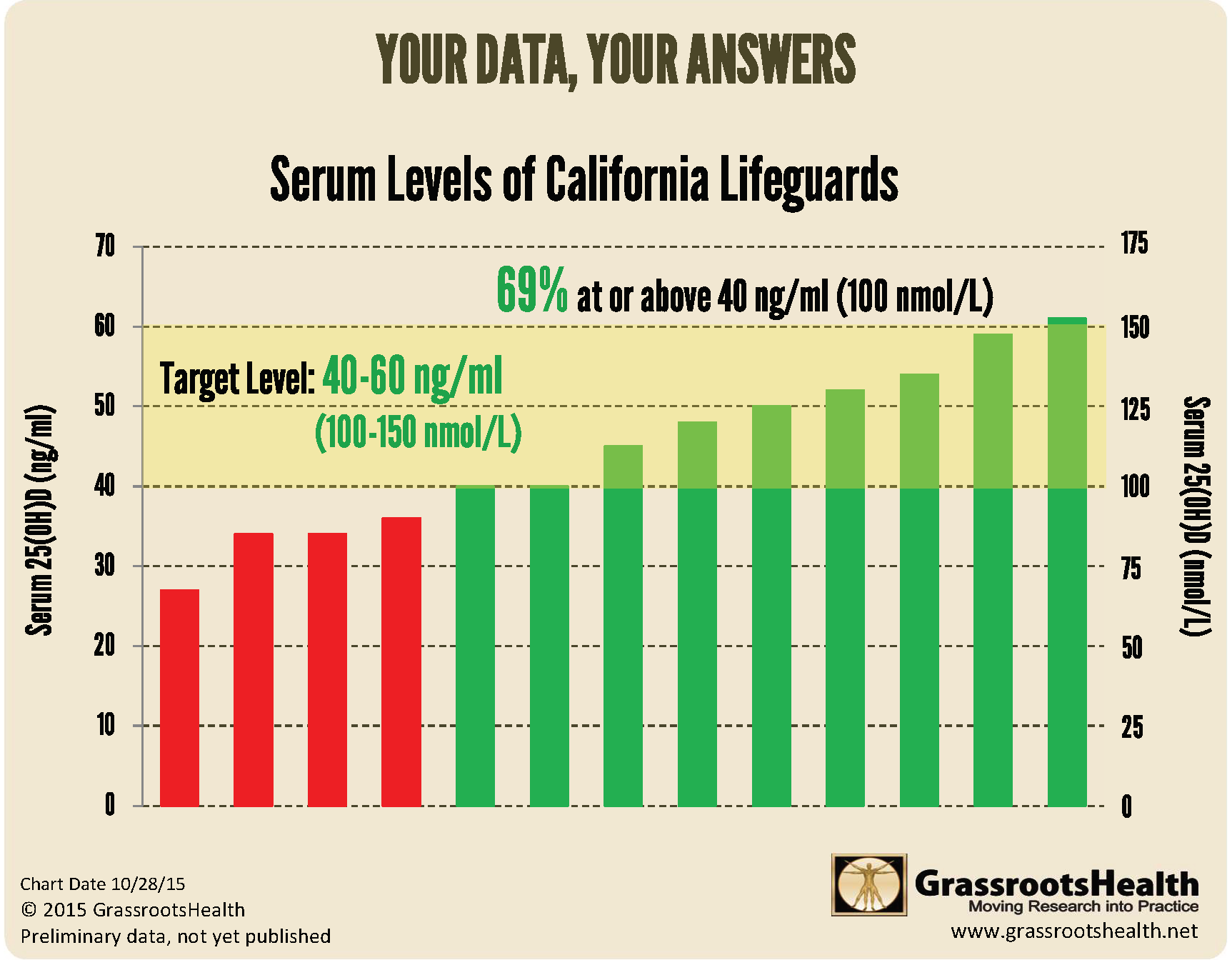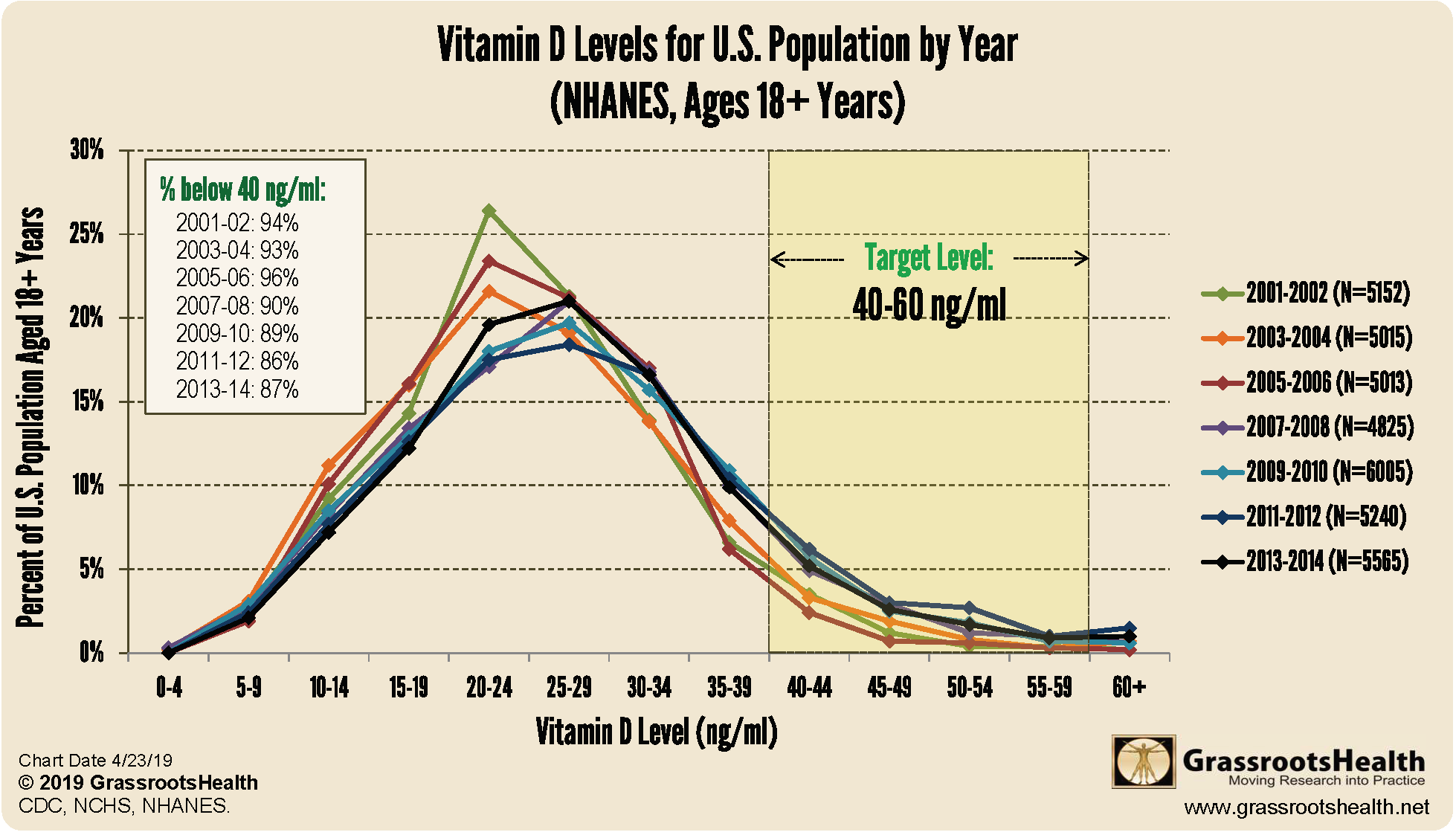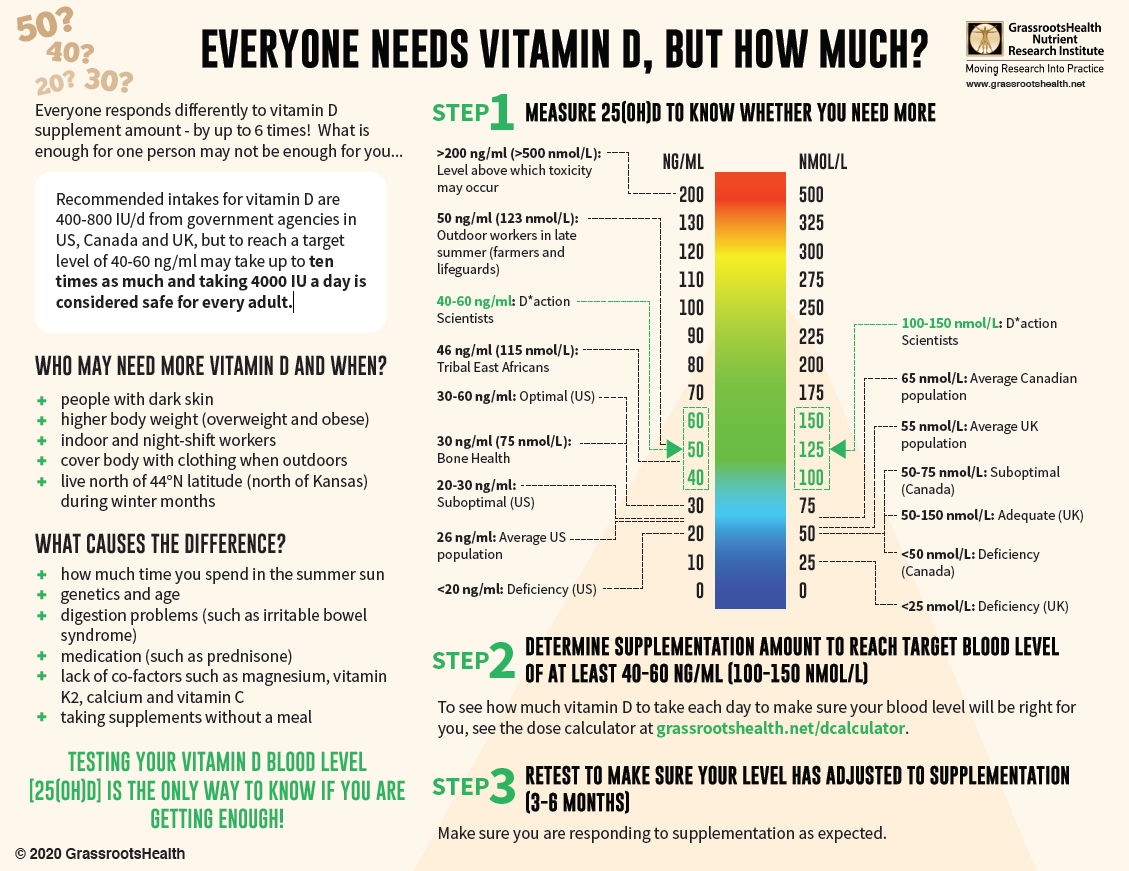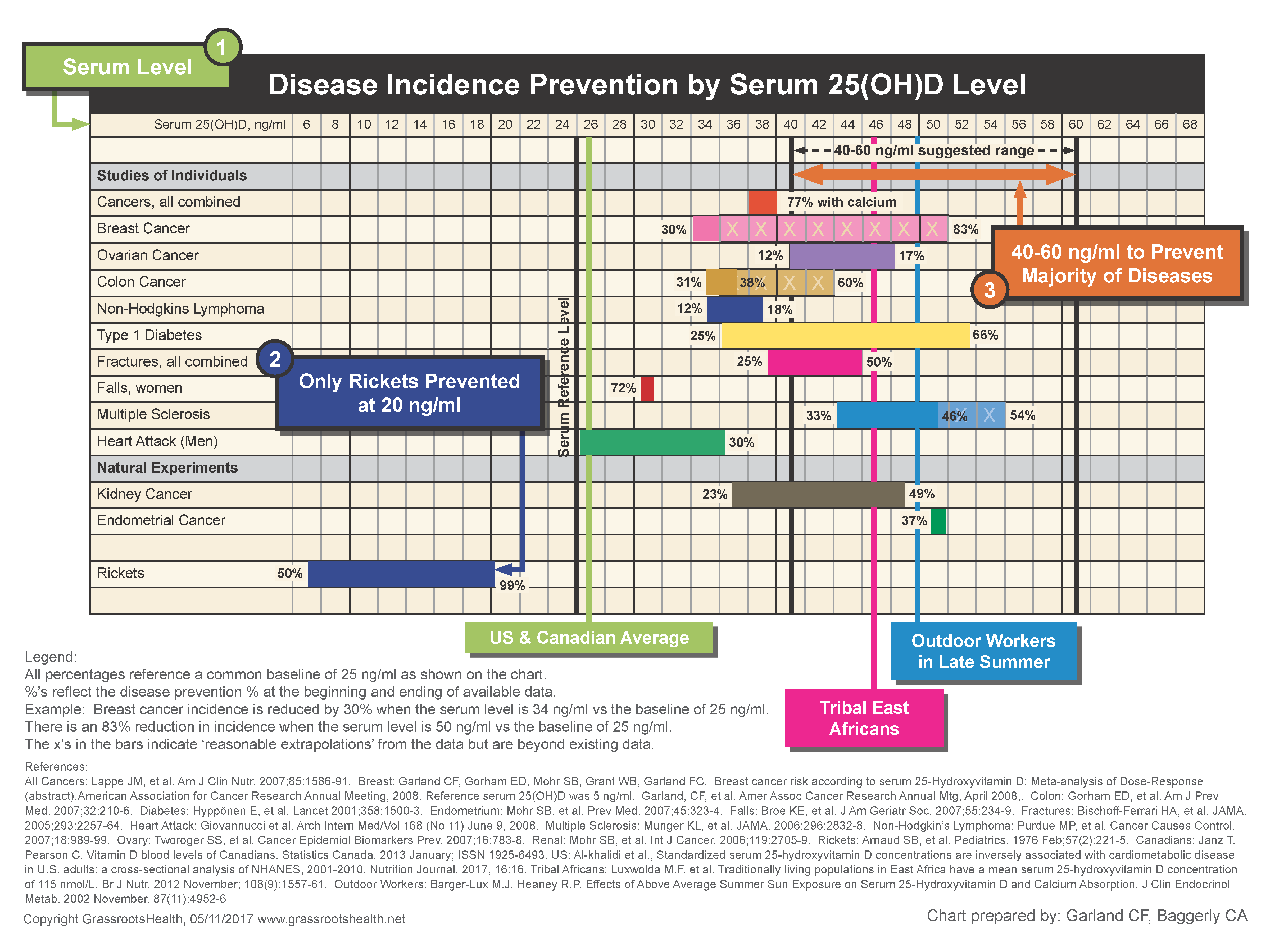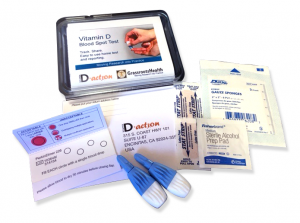Published on May 29, 2025
If given the chance, the body produces enough vitamin D from sunshine to reach levels of 40-60 ng/ml (100-150 nmol/L) or higher – could the body be ‘wrong’?

Centuries ago, Hippocrates (now considered the “Father of Medicine”) observed that the “sunnier side of the hill” was the healthier place to live. Because of this observation, he routinely prescribed sunbaths as part of his therapy for a wide variety of health ailments. While we now know that there are many benefits to proper sun exposure, the one with the greatest impact is most likely the production of vitamin D, and the reason it is dubbed the “sunshine vitamin.”
Today we wrap up Sunshine Month 2025 focusing back on the sunshine vitamin itself – and how getting enough vitamin D, while not a replacement for insufficient sunshine exposure, is essential to our health and wellbeing. What is enough? Let’s look to see how much vitamin D those exposing themselves to abundant sunshine naturally produce…
How Much Vitamin D Can the Body Produce From the Sun?
Our bodies naturally produce vitamin D from the sun under the right circumstances, such as the time of year or day, amount of clothing or sunscreen we are wearing, and other conditions that affect vitamin D production. Whether relying on the sun under these circumstances, or an ultraviolet lamp that produces UVB rays, the body is able to produce what is called an “erythema dose” of vitamin D – a term used by doctors to define the amount of ultraviolet radiation which results in a reddening of the skin. A minimal erythema dose is defined by a pinkness of the skin about 1-6 hours after sun exposure, going away within 24 hours. There is no single erythema dose or sun exposure time recommendation, due in part to differences in skin type and other individual differences in vitamin D production, but one minimal erythema dose is equivalent to roughly 10,000 – 25,000 IU of supplemental vitamin D! In other words, this is how much vitamin D your body can produce with a single ‘dose’ of healthy sunshine. Plus, the body will never produce too much vitamin D in response to sunlight – just the right amount.
What are Vitamin D Levels among Groups with Abundant Sun Exposure?
Based on evidence that humans originated in East Africa, Martine Luxwolda and Remko Kuipers, two Dutch researchers, assessed the vitamin D levels among 60 traditionally living Africans to determine the optimal vitamin D status from an evolutionary perspective. They found that the average vitamin D level from members of two ethnic groups was 46 ng/ml (115 nmol/L) and that 72% had levels of 40 ng/ml or higher. In a second study, these researchers assessed vitamin D levels among 449 traditionally living Africans from five ethnic groups. Similar to their first study, they found that the average vitamin D level was 43 ng/ml (107 nmol/L) in non-pregnant adults and 56 ng/ml (139 nmol/L) in pregnant women as shown in the chart below.
Click here for more information about these studies.
Additionally, GrassrootsHealth tested the vitamin D levels among a group of San Diego beach lifeguards at summer’s end. The average vitamin D level was 45 ng/ml, and as shown in the chart below, the majority of the lifeguards (69%) had vitamin D levels at or above 40 ng/ml. Since none of the lifeguards reported taking vitamin D supplements, observed vitamin D levels are primarily from sun exposure.
One of the initial goals of GrassrootsHealth was to determine a recommended range for a target vitamin D level that could achieve the best health outcomes for the majority of the population. The consensus reached was 40-60 ng/ml (100-150 nmol/L), and each of our 48 scientists on that panel agree that this level is not only safe, but also a desirable target for the benefit of multiple health outcomes, including prevention of cancer, heart disease and respiratory infections such as COVID-19.
Given that both a ‘natural’ and recommended range is 40-60 ng/ml, what are the vitamin D levels of the general population?
Using data from the National Health and Nutrition Examination Survey (NHANES), which collects health information from a representative sample of individuals living in the United States, the chart below presents the vitamin D levels for those aged 18 years and older by year (2001 to 2014). The average vitamin D level increased from 25 ng/ml in 2001-2002 to 28 ng/ml in 2013-2014 (62 to 69 nmol/L). The percent of adults below 20 ng/ml decreased from 26% to 23% during the same time period and those less than 40 ng/ml decreased from 94% to 87%. Even with these slight improvements, almost 90% of U.S. adults in the NHANES data set have a vitamin D level below the recommended range of 40-60 ng/ml!
Those Living in Higher Latitudes Have Even Lower Vitamin D Levels
Because less UVB rays are available year-round to make vitamin D at higher latitudes, the risk of vitamin D deficiency is even greater than many in the United States. The following graphic was created with the collaboration of top vitamin D researchers from around the world. As can be seen, average vitamin D levels among those living in Canada (26 ng/ml or 65 nmol/L) and the United Kingdom (22 ng/ml or 55 nmol/L) are even lower than the average vitamin D level of those in the United States. You can also see the average level of outdoor workers at the end of summer, which is 50 ng/ml (125 nmol/L) – much higher than the average population levels and the levels recommended by government agencies.
One of the most important messages conveyed with this graphic is that simply taking a recommended vitamin D supplement amount may not be providing enough vitamin D, especially when the current medical recommendations are too low for almost all people.
Recommended intakes for vitamin D are 400-800 IU/d from government agencies in US, Canada and UK, but to reach a target level of 40-60 ng/ml may take up to ten times as much and taking 4000 IU a day is considered safe for every adult.
An intake of 400 to 800 IU of vitamin D per day, especially during the winter when many people are stuck indoors, is certainly not enough vitamin D to support the levels needed for maintaining health. Obvious consequences of such low recommendations are the current average vitamin D levels among the general population. Remember, the amount needed for one person to achieve such levels may be much different than the amount needed for others.
Who May Need More Vitamin D and When?
- people with dark skin
- higher body weight (overweight and obese)
- indoor and night-shift workers
- cover body with clothing when outdoors
- live north of 44°N latitude (north of Kansas)
- during winter months
What Causes the Difference?
- how much time you spend in the summer sun
- genetics and age
- digestion problems (such as irritable bowel syndrome)
- medication (such as prednisone)
- lack of co-factors such as magnesium, vitamin K2, calcium and vitamin C
- taking supplements without a meal
A Remember of Why Vitamin D is Important
The following document summarizes 15 peer-reviewed, published papers regarding vitamin D levels and the risk of and certain conditions. It uses a reference level of 25 ng/ml, which means that the percentage reductions for each disease are based on raising levels from 25 ng/ml to the amount showing the percentage reduction. (25 ng/ml is close to the average vitamin D level in the US and Canada). Additional reference lines have been added to show levels of outdoor workers in late summer and for the average vitamin D level among tribal East Africans.
This document helps determine where you want your vitamin D serum level to be. Do you want to reduce your risk of cancer? Diabetes? Multiple Sclerosis? The next step would be to test your level with your doctor or through GrassrootsHealth.
Let’s All Reach Our ‘Natural’ Levels of Vitamin D!
As can be seen above, vitamin D deficiency is abundant – the good news is, it is easily corrected. While most of us cannot achieve a vitamin D level of 40-60 ng/ml (100-150 nmol/L) from sun alone, either due to our lifestyle, where we live, or other circumstances, we can certainly reach those levels with the right amount of supplementation.
Hippocrates also said “The greatest medicine of all is teaching people how not to need it” – so, how can you use the sunshine vitamin to benefit your health? What amount is right for you?
The only way to tell is to test your level of vitamin D – from there, use the vitamin D*calculator to help you determine a dose of vitamin D to achieve your desired target level, and choose either a regular daily maintenance dose (to reach your goal in approximately 3 months), or start with an initial “loading dose” to help bump it up more quickly (loading doses do not go above 25,000 IU per day, which is the amount our bodies can produce from proper sun exposure, and can help us reach our target level within only weeks). Learn what supplement amount you might need along with information provided on how to support and maintain a healthy vitamin D level (such as with co-nutrients, sun exposure, and food). Re-testing after 3 to 6 months allows you to ensure your target has been reached or gives you the opportunity to adjust your routine as needed.
Make Sure You are Getting Enough Sunshine and Vitamin D TODAY!
By joining the GrassrootsHealth projects, you are not only contributing valuable information to our study, but you are also gaining knowledge about how you could improve your own health through measuring and tracking your nutrient status, and educating yourself on how to improve it. Do you know what your status of vitamin D, omega-3s, and other essential nutrients is? Could your levels be improved? Test now to find out!


